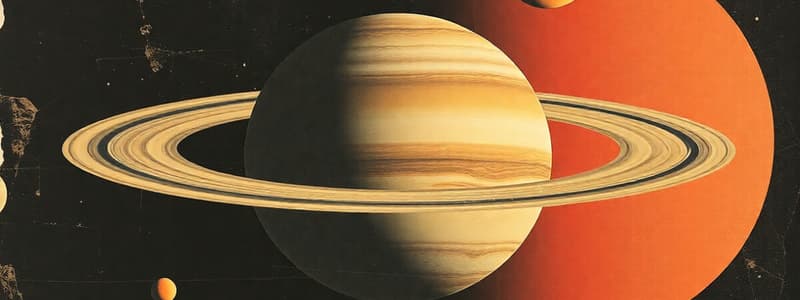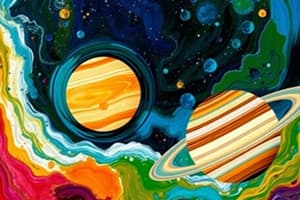Podcast
Questions and Answers
Why would an object weigh more on Saturn than on Earth?
Why would an object weigh more on Saturn than on Earth?
- Saturn has a true surface, unlike Earth.
- Saturn is less massive than Earth.
- Saturn has lower gravity than Earth.
- Saturn has greater gravity than Earth. (correct)
What is the primary composition of Saturn?
What is the primary composition of Saturn?
- Dense metallic core
- Mostly swirling gases and liquids (correct)
- Solid ice and frozen compounds
- Primarily rocky materials
What is unique about the hexagon-shaped pattern at Saturn's north pole?
What is unique about the hexagon-shaped pattern at Saturn's north pole?
- It is a global dust storm, larger than any on Mars.
- It is a large, dormant volcano.
- It is a magnetic anomaly affecting spacecraft navigation.
- It is a six-sided jet stream with a massive, rotating storm at the center. (correct)
Approximately how long does it take for Saturn to orbit the Sun?
Approximately how long does it take for Saturn to orbit the Sun?
What is a notable characteristic of Saturn's moon Titan?
What is a notable characteristic of Saturn's moon Titan?
Which of the following best describes the composition of Saturn's rings?
Which of the following best describes the composition of Saturn's rings?
How are Saturn's rings named?
How are Saturn's rings named?
What role do shepherd moons play in Saturn's ring system?
What role do shepherd moons play in Saturn's ring system?
Which spacecraft provided the first close-up study of Saturn?
Which spacecraft provided the first close-up study of Saturn?
What was a significant discovery made by Pioneer 11 regarding Saturn?
What was a significant discovery made by Pioneer 11 regarding Saturn?
What was the contribution of the Voyager spacecraft to the study of Saturn?
What was the contribution of the Voyager spacecraft to the study of Saturn?
What was the key feature of the Cassini mission's final phase?
What was the key feature of the Cassini mission's final phase?
Which probe, carried by Cassini, landed on Titan?
Which probe, carried by Cassini, landed on Titan?
What honor does the Huygens Probe hold?
What honor does the Huygens Probe hold?
What is the Roman name given to Saturn?
What is the Roman name given to Saturn?
What is true of Saturn compared to Earth?
What is true of Saturn compared to Earth?
Why is Saturn called a gas giant?
Why is Saturn called a gas giant?
How long does it take for sunlight to reach Saturn?
How long does it take for sunlight to reach Saturn?
Saturn has the second shortest day in the solar system. How long does it take?
Saturn has the second shortest day in the solar system. How long does it take?
How many moons does Saturn have?
How many moons does Saturn have?
Flashcards
What is Saturn's position from the Sun?
What is Saturn's position from the Sun?
Saturn is the sixth planet from the Sun and the second largest in our solar system.
What is Saturn made of?
What is Saturn made of?
Saturn is a gas giant made mostly of hydrogen and helium, lacking a true surface.
What is Saturn's North Pole feature?
What is Saturn's North Pole feature?
A six-sided jet stream at Saturn's north pole, a unique atmospheric feature.
How long is a day and year on Saturn?
How long is a day and year on Saturn?
Signup and view all the flashcards
How many moons does Saturn have?
How many moons does Saturn have?
Signup and view all the flashcards
What are Saturn's rings made of?
What are Saturn's rings made of?
Signup and view all the flashcards
What are Shepherding Moons?
What are Shepherding Moons?
Signup and view all the flashcards
Which was the first spacecraft to study Saturn?
Which was the first spacecraft to study Saturn?
Signup and view all the flashcards
What did the Cassini mission accomplish?
What did the Cassini mission accomplish?
Signup and view all the flashcards
What landed on Titan?
What landed on Titan?
Signup and view all the flashcards
What is Saturn's gravity?
What is Saturn's gravity?
Signup and view all the flashcards
What is special about Titan's atmosphere?
What is special about Titan's atmosphere?
Signup and view all the flashcards
Study Notes
- Saturn is the sixth planet from the Sun and the second largest in the solar system.
- Saturn's width is nine times that of Earth.
- Over 700 Earths could fit inside Saturn.
- The planet is named after Saturnus, the Roman god of agriculture and wealth, and father of Jupiter.
- Sunlight takes 80 minutes to reach Saturn from the Sun.
- Like Jupiter, Saturn consists mostly of hydrogen and helium.
- Being a gas giant, Saturn lacks a true surface.
- Saturn is composed of swirling gases and liquids in the deeper layers and has a thick atmosphere.
- Saturn's gravity is about 1.08 times that of Earth.
- An object weighing 100 lbs on Earth would weigh 108 lbs on Saturn.
Saturn's North Pole
- Saturn's north pole has a six-sided jet stream.
- The hexagon-shaped pattern was first observed by the Voyager I spacecraft and later by the Cassini spacecraft.
- The six-sided jet stream can fit two Earths across.
- A massive, rotating storm is at the center of the jet stream.
- The weather feature does not exist anywhere else in the solar system.
Saturn's Rotation and Orbit
- Saturn has the second-shortest day in the solar system, lasting about 10.7 or 11 hours.
- Saturn completes an orbit around the Sun in about 29.4 Earth years (10,756 Earth days).
- As of June 8, 2023, Saturn has 146 moons.
- Saturn's largest moon, Titan, has an Earth-like cycle of liquids flowing across its surface and has a thick atmosphere.
- Titan is larger than Mercury and is the second largest moon in the solar system.
- Enceladus has a global ocean under a thick, icy shell.
- Enceladus and Titan are high-priority science destinations for future deep space missions.
Saturn's Rings
- Saturn's rings are made of pieces of comets, asteroids, or shattered moons, torn apart by Saturn's gravity.
- The rings consist of billions of small chunks of ice and rock coated with other materials, including dust.
- Most ring particles are icy grains, ranging from tiny, dust-sized to chunks as big as a house, with a few particles as large as mountains.
- How Saturn's rings formed is currently unknown.
- The rings are thought to have something to do with Saturn's moons.
- The rings could be made from broken pieces of moons.
- The rings may also be made from material left over when Saturn first formed.
- From a distance, Saturn appears to have seven large rings, each named with a letter of the alphabet.
- The rings were named in the order they were discovered.
- The first ring discovered was named the A ring, and it is not the closest or farthest ring from Saturn.
- Some rings are close together, while others have large gaps between them.
- The rings circle Saturn at very high speeds.
- The ring system is divided into seven groups of rings.
- These rings are as wide as four and a half Earths.
- The rings stay on track and intact due to Saturn's smallest moons, called Shepherding Moons.
- These tiny moons orbit between the rings and use their gravity to shape the rings.
- Pandora and Prometheus are examples of shepherd moons that keep the F-ring narrow.
Saturn's Exploration
- Four robotic spacecraft have visited Saturn.
- Pioneer 11 was the first spacecraft to study Saturn up close, with the first close look in September 1979.
- Pioneer 11 discovered Saturn's F ring and a new moon.
- NASA's twin Voyager 1 and Voyager 2 followed up with flybys nine months apart in 1980 and 1981.
- Voyager 1 revealed the intricate structure of the ring system.
- Voyager 2 provided more detailed images and documented the thinness of some of the rings.
- The international Cassini mission arrived in 2004 and orbited 294 times.
- Cassini studied Saturn for 13 years and was transformed into an atmospheric probe.
- Cassini plunged into Saturn's atmosphere in September 2017, sending science data back to Earth.
- Its final five orbits enabled scientists to directly sample Saturn's atmosphere.
- Cassini carried ESA's Huygens Probe, which landed on Saturn's moon Titan in 2005.
- Huygens Probe was the first spacecraft to make a soft landing on the surface of another planet's moon, Titan.
Studying That Suits You
Use AI to generate personalized quizzes and flashcards to suit your learning preferences.




